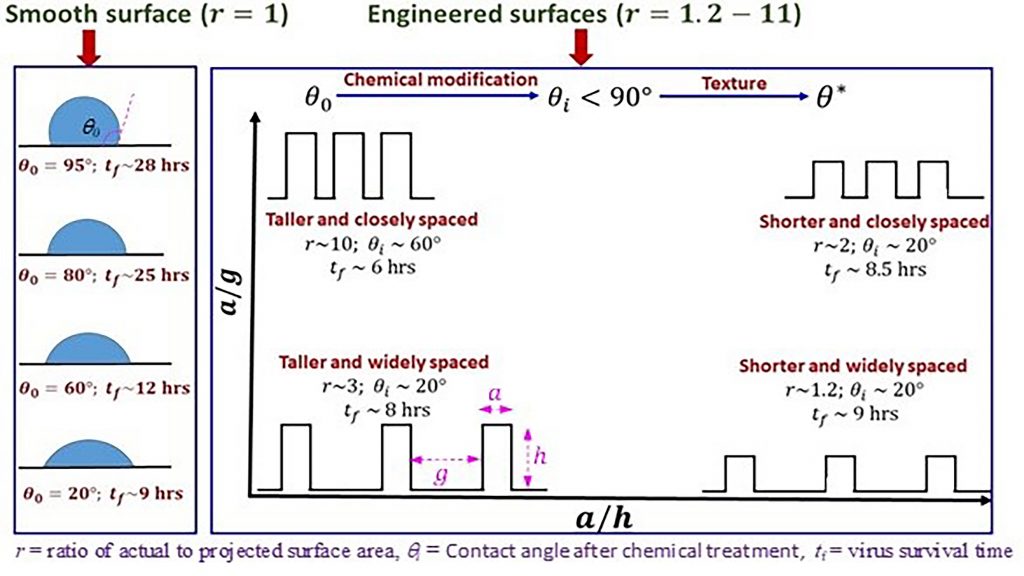From the Journal: Physics of Fluids
WASHINGTON, May 4, 2021 — If a respiratory droplet from a person infected with COVID-19 lands on a surface, it becomes a possible source of disease spread. This is known as the fomite route of disease spread, in which the aqueous phase of the respiratory droplet serves as a medium for virus survival.

The lifespan of the respiratory droplet dictates how likely a surface is to spread a virus. While 99.9% of the droplet’s liquid content evaporates within a few minutes, a residual thin film that allows the virus to survive can be left behind.
This begs the question: Is it possible to design surfaces to reduce the survival time of viruses, including the coronavirus that causes COVID-19? In Physics of Fluids, from AIP Publishing, IIT Bombay researchers present their work exploring how the evaporation rate of residual thin films can be accelerated by tuning surfaces’ wettability and creating geometric microtextures on them.
An optimally designed surface will make a viral load decay rapidly, rendering it less likely to contribute to the spread of viruses.
“In terms of physics, the solid-liquid interfacial energy is enhanced by a combination of our proposed surface engineering and augmenting the disjoining pressure within the residual thin film, which will speed drying of the thin film,” said Sanghamitro Chatterjee, lead author and a postdoctoral fellow in the mechanical engineering department.
The researchers were surprised to discover that the combination of a surface’s wettability and its physical texture determine its antiviral properties.
“Continuously tailoring any one of these parameters wouldn’t achieve the best results,” said Amit Agrawal, a co-author. “The most conductive antiviral effect lies within an optimized range of both wettability and texture.”
While previous studies reported antibacterial effects by designing superhydrophobic (repels water) surfaces, their work indicates antiviral surface design can be achieved by surface hydrophilicity (attracts water).
“Our present work demonstrates that designing anti-COVID-19 surfaces is possible,” said Janini Murallidharan, a co-author. “We also propose a design methodology and provide parameters needed to engineer surfaces with the shortest virus survival times.”
The researchers discovered that surfaces with taller and closely packed pillars, with a contact angle of around 60 degrees, show the strongest antiviral effect or shortest drying time.
This work paves the way for fabricating antiviral surfaces that will be useful in designing hospital equipment, medical or pathology equipment, as well as frequently touched surfaces, like door handles, smartphone screens, or surfaces within areas prone to outbreaks.
“In the future, our model can readily be extended to respiratory diseases like influenza A, which spread through fomite transmission,” said Rajneesh Bhardwaj, a co-author. “Since we analyzed antiviral effects by a generic model independent of the specific geometry of texture, it’s possible to fabricate any geometric structures based on different fabrication techniques — focused ion beams or chemical etching — to achieve the same outcome.”
###
For more information:
Larry Frum
media@aip.org
301-209-3090
Article Title
Designing antiviral surfaces to suppress the spread of COVID-19
Authors
Sanghamitro Chatterjee, Janani Srree Murallidharan, Amit Agrawal, and Rajneesh Bhardwaj
Author Affiliations
Indian Institute of Technology Bombay
